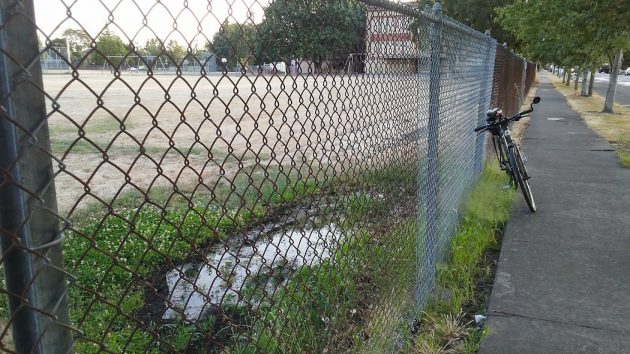
Looking west along Ninth Avenue toward, in the background, Central School on Aug. 5.
In the dry desert that is the field outside of Albany’s Central School this summer, there’s what you might call an oasis. It has greenery and even a watering hole, as you can see in the photo above.
A reader called my attention to this phenomenon, evidently thinking I might want to point it out. His point was that this apparent leak in a water line amounts to a good deal of wasted water and should be fixed.
He’s right, of course. On the other hand, is there is a chance this might be a natural spring? Probably not, considering the land is flat for miles on all sides. Little chance of artesian action here, is there?
A map of the Albany water system available online shows a meter in the general vicinity, along with a service line for irrigation of the northeast sector of the school grounds. This is where the wet spot is, more or less. So chances are there’s a connection.
Will the school district want to go to the expense of digging up the pipes and replacing them? It probably depends on how much, if at all, the leak affects Central School’s water bill. The Albany school system faces enough challenges now, and a wet spot in the grass may not rise to the top of the list of things to do.
So why point it out? Because this is a blog mostly about things around town, often things I see and can take a picture of while riding a bike. And after somebody asked me about this, I did just that. (hh)


Positive side it provides water for birds and neighborhood cats. Neg side it probably would cost more to fix than the leak is costing the meter in a higher water bill.
Since the City of Albany adds fluoride to the drinking water, it is extremely easy to determine if this is system water or a natural spring. Ask the City to stop by and check on it. The field test takes about two minutes.
Maybe it’s a designated “wet spot” for underprivileged mosquitos?
Why would the school district actually care? For them it’s OPM and if they run short they just do another “It’s for the children” levy and taxpayers will write another check.
A wetland for which the city traded for the property off Lochner?
It should be clearly understood that a leaking pipe also presents an access point for contaminants to enter a potable water supply. That’s why irrigation system require functioning backflow preventers.
I believe that the primary reason that back-flow prevention is required on irrigation wells is that the irrigation systems are frequently used for “fertigation,” where nutrients are injected into the water in the lines to fertilize the crop being watered.
Irrigation wells often run a cycles and when shut off there is the possibility of the pipes draining back into the well which could cause contamination of the water source.
City water systems are presumably constantly pressured. This, I would think, would prevent ambient water from entering into the pressurized system.
You’re wrong George. It to prevent water from being sucked back from any irrigation, or any other use from potable water supplies.
Call Public Works at the city for more information.
I will take your comments under advisement Bob but will probably go to the OWRD as as my preferred source of information. They check our irrigation well quarterly.